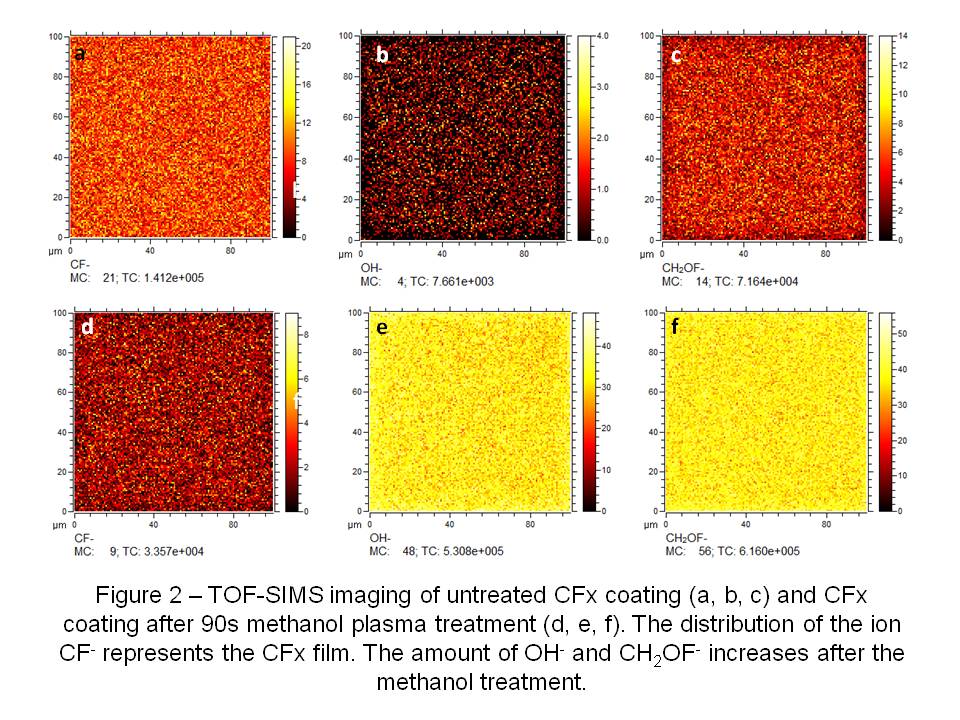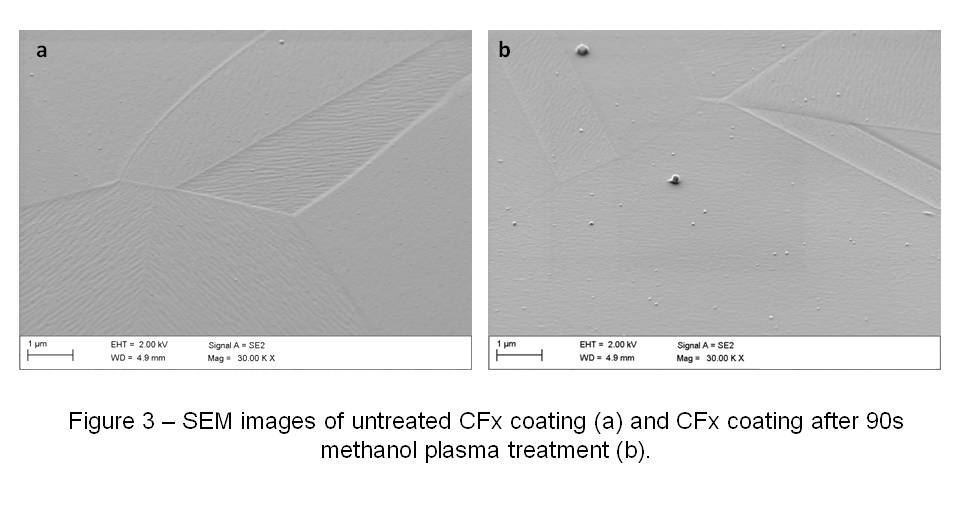Introduction: The surgical implantation of metallic stents in a narrowed vessel after balloon angioplasty is a common procedure to prevent restenosis phenomena, but the related complications, such as thrombosis, inflammation and devices corrosion, are still a serious concern.
In order to limit those complications, the coating of metallic stents, by Plasma Enhanced Chemical Vapor Deposition (PECVD), with Fluorocarbon (CFx) ultrathin films has been demonstrated to be an interesting strategy, thanks to the CFx biocompatibility, chemical inertness, impermeability, corrosion resistance, appropriate mechanical properties and high adhesion to the substrates[1],[2].
Nevertheless, the modification of some key surface properties of CFx coatings could further improve their blood compatibility. For example, it has been shown that the presence of carboxyl groups and a moderate surface wettability could promote the appropriate proteins adhesion, improving the hemocompatibility and promoting the surface endothelialisation[3],[4].
The objective of this work was to develop an oxidation process of CFx coatings, based on a methanol plasma treatment. The modification of the surface oxygen content and wettability was aimed to modulatie protein adsorption and blood compatibility of CFx films, without affecting their excellent mechanical and corrosion resistance properties.
Materials and Methods: 316L stainless steel (SS) substrates were electropolished and coated with CFx coatings by PECVD, as previously reported[1]. CFx coatings were then modified by methanol plasma treatments, carried out in the same reactor. The chemical composition of the surfaces was analysed by X-ray Photoelectron Spectroscopy and Time-of-Flight Secondary Ion Mass Spectrometry (TOF-SIMS); the surface energy was evaluated by static water contact angle measurements; the morphology and the roughness were studied by Scanning Electron Microscopy (SEM) and Atomic Force Microscopy (AFM). The elastic properties and the adhesion of the films to the substrates were evaluated by Contact Resonance-AFM and Torsional Harmonix-AFM and Small Punch tests, respectively. Corrosion tests were performed to analyse the corrosion behaviour of the samples. The hemocompatibility of the surfaces was studied by kinetic clotting time tests.
Results and Discussion: The analysis of the chemical composition and surface wettability showed a decrease of the surface hydrophobicity and an increase of oxygen content on the CFx coated surfaces with the increase of duration of methanol treatment, as shown in Figure 1 and Figure 2.


No significant variation in surface morphology (Figure 3), roughness, mechanical and corrosion resistance properties could be observed between the untreated and treated coatings. However, clotting time tests showed an improved hemocompatibility of the oxidized CFx coatings with respect to both the bare electropolished stainless steel substrates and the untreated CFx films.

Conclusions: Tunable oxidation of the surface of CFx coatings was successfully obtained by methanol plasma treatment, thus producing an increase of surface wettability, without affecting morphology, roughness and mechanical properties of the coatings. Blood test results showed an increased hemocompatibility of the oxidized and more hydrophilic samples, indicating the possibility of modulating the blood contact behaviour of the CFx coatings through the modulation of their surface energies.
This work was partially funded by NSERC-Canada, FRQ-NT Quebec, CFI-Canada. Livia Angeloni was awarded of a doctoral scholarship from IItalian Ministery of Research and Education.; Vanessa Montano Machado was awarded of a doctoral scholarship from CONACYT – National Council of Science and Technology, Mexico.; ToF-SIMS analysis were performed by Céline Noël at the Research Centre in Physics of Matter and Radiation (PMR) in Namur University, Belgium. The authors would like to express their gratitude for their collaboration on the performance of experiments to Laurent Houssiau and Jean-Jacques Pireaux.
References:
[1] Haidopoulos M, Turgeon S, Laroche G, Mantovani D, Chemical and Morphological Characterization of Ultra-Thin Fluorocarbon Plasma-Polymer Deposition on 316 Stainless Steel Substrates: A First Step Toward the Improvement of the Long-Term Safety of Coated-Stents Plasma Process Polym 2005; 2:424–440.
[2] Lewis F, Maheux-Lacroix B, Turgeonc S, Mantovani D. Evaluation of the Adhesion of Ultra-Thin Teflon-Like Films Deposited by Plasma on 316L Stainless Steel for Long-Term Stable Drug-Eluting Stents. Adv Mat Res 2007; 15-17:119-124
[3] Thevenot P, Hu W, Tang L. Surface chemistry influences implant biocompatibility. Curr Top Med Chem 2008;8(4):270-280.
[4] Arima Y, Iwata H. Effect of wettability and surface functional groups on protein adsorption and cell adhesion using well-defined mixed self-assembled monolayers. Biomaterials 2007;28(20):3074-3082.